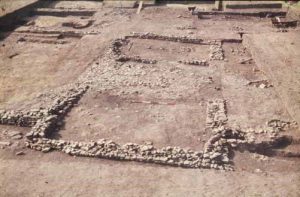November 27, 2019, by Maria Benedetto Mozo
DTH Spotlight: The Archaeology Slide Collection Digitisation Project
What is in the collection?
The Archaeology Department Slide Collection contains over 15,000 35mm slides. The slides include large numbers of images of archaeological sites, objects and plans covering local, regional and national subjects that were used for teaching purposes.
However, within this general collection there are more important slides which form a visual record of the Department’s research excavations in the second half of the 20th century. For example, the Roman cemetery at Ancaster, excavations by Dr Malcolm Todd at the Roman town of Margidunum, and excavations of Anglo-Saxon pottery kilns at Torksey.
The slides also include the Maurice Barley photographic archive; Barley was the first Professor of Archaeology at the University of Nottingham and was a well-known expert on historic buildings, and his photograph collection includes many images of buildings which have since been demolished, making them an important national record.
What are DTH volunteers doing?
They are working on a project to digitise the Archaeology department’s Slide Collection.
First: They assess the contents using guidelines provided by Dr Chris King to identify the key sub-collections. These are carefully catalogued using information from the slides themselves and also the corresponding card index.
Next: Using this information and the guidelines provided by Chris and the Archaeology Museum’s Mark Laurie, the students populate a database of metadata and produce a unique catalogue number that will be used to cross-reference the images and data.
After that: The students digitise the slides using one of the DTH’s two Epson Perfection V800 flatbed scanners and a workflow created by DTH’s Matt Davies and Manuscripts and Special Collection’s Mark Bentley.
Finally: These produce high-resolution digital versions of the slides that will ultimately allow searchable access to the images. Since 25mm slides deteriorate over a period turning pink or yellow, this will also preserve them!
No comments yet, fill out a comment to be the first



Leave a Reply